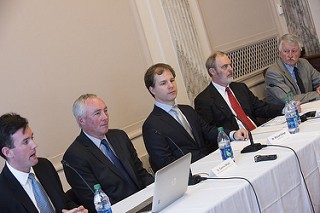
Event Summary: Understanding What’s Next in Fusion Technology
Podcast: Play in new window | Download
Subscribe: Apple Podcasts | RSS
On Tuesday, December 15, the American Security Project hosted Understanding What’s Next in Fusion Technology – an event that featured prominent scientists from nuclear fusion labs and companies.
ASP’s Andrew Holland began by briefly explaining the fundamental science behind fusion energy and the developments that have taken place thus far. “It’s something that’s happening right now in labs in this country and all across the world,” he stated.
The first speaker, Dr. Dennis Whyte of MIT, followed up by discussing the need for more R&D research. Doing so, he argued, would make reliable magnetic fields within reach. Dr. Whyte predicted that a modest 5-year investment could potentially lead to a small-size demonstration. He then discussed his planned ARC reactor and noted that the science for the reactor is proven, but the risk is in developing the technology for such a break through.
Mr. Michael Delage of General Fusion supplemented Dr. Whyte’s input by highlighting the progress the Canadian company has made so far utilizing magnetized target fusion. “The technology for making the plasma that we need has come a long way… so we can actually start to build these things at large scale,” he claimed.
Likewise, Dr. Douglas Witherspoon of HyperV Technologies Corp. discussed the progress his company has made using plasma jet magneto inertial fusion. He explained the plasma liner experiment (funded by ARPA-E), which will see its first experiments next year. He also noted that improvements still need to occur, especially with engineering.
Lastly, Dr. Richard Barth of Tri-Alpha Energy talked about the company’s methodology, including the proposed usage of boron isotopes in order to ensure that there is no leftover radiation. The work so far has garnered much attention, though more research will occur after modifying and rebuilding their equipment.
The Q&A session followed Barth’s presentation.
The first question dealt with an issue that resonates with most investors: timelines. Delage remained hesitant to give a concrete timespan, noting the uncertainties generated by development risks. They key, he argued, is to get the rest of the energy sector excited about fusion energy. Doing so would possibly set a timeline of about 10 years, though he cautioned that this requires complete participation of the energy sector.
Whyte added that a variety of approaches will definitely help, and that we should not wait too long on fusion.
When asked about the fossil fuel industries’ response to fusion energy, Holland stated that he has not seen any mischief. Mr. Delage went further, noting that one of General Fusion’s investors is a Canadian oil company.
When asked about funding, Dr. Witherspoon admitted that attracting private funding remains difficult, as the payoff does not occur in only a few years.
This might signal competitiveness among the companies, which certainly exists; however, the panel unanimously expressed their desire to see any company succeed, hence the collaborative efforts seen among the companies and laboratories.
This is also why they want fusion to serve as a viable discussion topic regarding energy security. The more attention and funding fusion projects receive, the more likely a project somewhere in the world will succeed. This will not wipe out all other projects and companies, though. As Dr. Witherspoon stated, “Somebody winning in making fusion work helps all of us.”
Umair Irfan of E&E News also covered this event. You can read his summary, entitled “ENERGY: Fusion reactors, when proven, could bypass financial hurdles in nuclear industry.”






